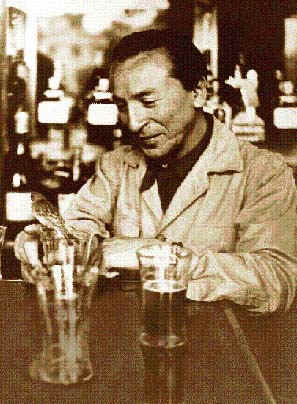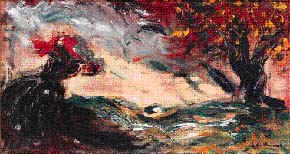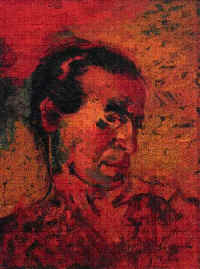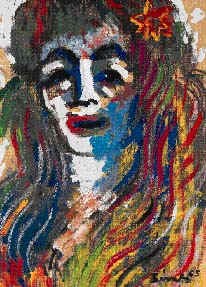Twentieth century Peruvian art has one of its most notable and
personal examples in Sérvulo Gutiérrez (1914-1961). An ambitious exhibit of his works on
display from September 10th to November 8th in the Lima Art Museum, made the public
viewing of his art possible, and which, despite its acceptance and initial success did not
generate a group of followers.  Desert,
valley and oasis. Ica, the city where Sérvulo Gutiérrez was born, was the starting point
for a sensitive and innate talent which led him to express himself through drawings, since
his early childhood days. His first works: portraits, landscapes and the image of the
Señor de Luren (Lord of Luren), allowed him to develop, in several stages and with
diverse styles, an extraordinary capability of creative freedom and a full display of his
expressiveness.
Desert,
valley and oasis. Ica, the city where Sérvulo Gutiérrez was born, was the starting point
for a sensitive and innate talent which led him to express himself through drawings, since
his early childhood days. His first works: portraits, landscapes and the image of the
Señor de Luren (Lord of Luren), allowed him to develop, in several stages and with
diverse styles, an extraordinary capability of creative freedom and a full display of his
expressiveness.
Not quite a teenager when his mother passed away, Sérvulo arrived in Lima and joined
the family of his eldest brother Alberto, a well-known restorer who taught him his initial
techniques.
Buenos Aires (where he traveled to as part of a Peruvian boxing delegation) and Paris
are the two environments in which this artist suffered experiences that would inevitably
affect him for the rest of his life. His contact with other places and people not only
gave him a new sense of direction, but also formed the character of his images. His
overflowing vitality led him to capture and enjoy the bohemian spirit that would accompany
him until his death. His return to both Lima and Buenos Aires also influenced his decision
to take up art as his life´s work.

Self made artist
It is unknown whether Sérvulo actually attended an academy, or was the pupil of a
professor, such as the artist Emilio Pettoruti, for whom Gutiérrez professed his
outspoken admiration and respect. Pettoruti, a disciplined, intelligent and determined
man, a defender of modern art sought by the spirit of those times, deeply influenced
Sérvulo.
The portraits of Claudine, of close kin, rooftop images and urban scenes of Buenos
Aires, painted between 1944 and 1946 stem from Sérvulos´ contact with artists proposing
new forms of interpreting and representing reality.
In 1946, Sérvulo began to exercise a chromatic freedom without complexes. The use of
complements, the rich quality of the formal mass based on blues, yellows and browns, all
properly arranged, allowed him to achieve a personal and final rhetoric. The memorable
portraits of Chepa Schwab and Doris Gibson, and even his self-portrait, in which his
search for the colors of the soul invades the overall scene, are from this stage.
Gutiérrez discovered that painting is color; that the line is not final and is an
unwanted limitation for his ambitions of expression. This intense feeling led him to
abandon precision drawing. He moved toward the ´rhythm` of the rebellious masses, and
once mastered, he continued on to portray the idea of an internal, intimate and shared
landscape, to illustrate his initial experiences.

Hasty Life
His trips to Ica would become more frequent. By 1951, this city was a motivating factor
in his paintings of Laguna Huacachina, La Huega, the desert, palm trees, the Huarangos and
the always stunning Ica sunsets.
His paintings of Christ´s image and numerous sketches remain engraved in some very
unexpected places: wrapping paper, scarves, napkins, cardboard, and just about any public
space he could find. This frenzy of work was encouraged by deep anxiety while a
continuously rushed and pressing lifestyle slowly weakened his physical and spiritual
resources.

An extensive and coherent collection of works remain as a result of his absolute
sincerity by achieving self-acceptance, free from fears or prejudices, with no intentions
other than expressing his limitations. Because of this loyalty towards his true self,
based on talent and energy, we admire his works with their qualities and faults,
corresponding to a fulfilling life.
![]()
![]()
![]() http://www.rumbosperu.com
http://www.rumbosperu.com